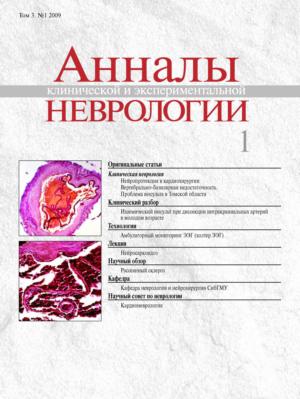Современное состояние проблемы рассеянного склероза
- Авторы: Переседова A.В.1, Завалишин И.A.1
-
Учреждения:
- ФГБНУ «Научный центр неврологии»
- Выпуск: Том 3, № 1 (2009)
- Страницы: 43-47
- Раздел: Обзоры
- Дата подачи: 07.02.2017
- Дата публикации: 14.02.2017
- URL: https://annaly-nevrologii.com/journal/pathID/article/view/380
- DOI: https://doi.org/10.17816/psaic380
- ID: 380
Цитировать
Полный текст
Аннотация
Мультифакториальная теория этиологии рассеянного склероза предполагает взаимодействие экзогенных факторов внешней среды и генетической предрасположенности. Концепция патогенеза этого заболевания в настоящее время включает выделение начальной воспалительной фазы, сопровождающейся фазой демиелинизации, а затем фазой нейродегенерации. В статье рассматриваются механизмы иммуно-воспалительных реакций, аксонального повреждения и репаративных изменений при рассеянном склерозе. Сейчас обсуждаются две схемы его терапии: эскалационная и индукционная. Одним из основных принципов является раннее назначение лечения, модулирующего течение болезни. Приведены результаты сравнительного анализа клинической эффективности иммуномодулирующих препаратов первой линии (интерфероны-бета и глатирамера ацетат). Обсуждаются использование цитостатических препаратов и перспективы патогенетической терапии рассеянного склероза.
Ключевые слова
Об авторах
A. В. Переседова
ФГБНУ «Научный центр неврологии»
Email: a.v.pesedova@mail.ru
Россия, Москва
И. A. Завалишин
ФГБНУ «Научный центр неврологии»
Автор, ответственный за переписку.
Email: a.v.pesedova@mail.ru
Россия, Москва
Список литературы
- Завалишин И.А., Переседова А.В., Стойда Н.И. и др. Сравнительный анализ эффективности иммуномодулирующей терапии рассеянного склероза ребифо-22 мкг, бетафероном и копаксоном (результаты 3 лет лечения). Журнал неврологии и психиатрии им. С.С. Корсакова 2007; 4 («Рассеянный склероз»): 99–105.
- Arnold D.L., Campagnolo D., Panitch H. et al. Glatiramer acetate after mitoxantrone induction improves MRI markers of lesion volume and permanent tissue injury in MS. J. Neurol. 2008; 255(10): 1473–1478.
- Ascherio A. Epstein–Barr virus in the development of multiple sclerosis. Expert Rev. Neurotherapeutics 2008; 8 (3): 331–333.
- Baranzini S.E., Wang J., Gibson R.A. et al. Genome-wide association analysis of susceptibility and clinical phenotype in multiple sclerosis. Hum. Mol. Genet. 2009; 18 (4): 767–778.
- Brown K.A. Factors modifying the migration of lymphocytes across the blood-brain barrier. Int. Immunopharmacol. 2001; 1: 2043–2062.
- Buckle G.J. Functional magnetic resonance imaging and multiple sclerosis: the evidence for neuronal plasticity. J. Neuroimaging 2005; 15 (Suppl. 4): 82S–93S.
- Capobianco M., Rizzo A., Malucchi S. et al. Glatiramer acetate is a treatment option in neutralising antibodies to interferonМbetaМpositive patients. Neurol. Sci. 2008; 29 (Suppl. 2): S227–229.
- Christensen T. Association of human endogenous retroviruses with multiple sclerosis and possible interactions with herpes viruses. Rev. Med. Virol. 2005; 15; 179–211.
- Christensen T. Human Herpesviruses in MS. Int. MS J. 2007; 14 (2): 41–47.
- Christensen T. The role of EBV in MS pathogenesis. Int. MS J.2006; 13: 52–57.
- Clausen J. Endogenous retroviruses and MS: using ERVs as disease markers. Int. MS J. 2003; 10: 22–28.
- Comi G. Induction vs. escalating therapy in multiple sclerosis: practical implications. Neurol. Sci. 2008; 29 (Suppl. 2): S253–255.
- Compston A. Mechanisms of axon-glial injury of the optic nerve. Eye 2004; 18 (11): 1182–1187.
- Compston A., Coles A. Multiple sclerosis. Lancet 2008; 372 (9648):1502–1517.
- Confavreux C., Vukusic S. Multiple sclerosis: a degenerative disease? Bull. Acad. Natl. Med. 2008; 192 (3): 483–491.
- Coyle P.K. Early treatment of multiple sclerosis to prevent neurologic damage. Neurology 2008; 71 (24, Suppl. 3): S3–7.
- Dong C., Flavell R.A. Cell fate decision: T-helper 1 and 2 subsets in immune responses. Arthritis Res. 2000; 2: 179–188.
- Filippi M., Bozzali M., Rovaris M. et al. Evidence for widespread axonal damage at the earliest clinical stage of multiple sclerosis. Brain 2003; 126: 433–437.
- Filippi M., Rocca M.A. Cortical reorganisation in patients with MS.J. Neurol. Neurosurg. Psychiatry 2004; 75 (8): 1087–1089.
- Filippi M., Rocca M.A. Disturbed function and plasticity in multiple sclerosis as gleaned from functional magnetic resonance imaging. Curr. Opin. Neurol. 2003; 16 (3): 275–282.
- Fong J.S., RaeбGrant A., Huang D. Neurodegeneration and neuroprotective agents in multiple sclerosis. Recent Pat. CNS Drug Discov. 2008; 3 (3): 153–165.
- Freedman M.S. Induction vs. escalation of therapy for relapsing multiple sclerosis: the evidence. Neurol. Sci. 2008; 29 (Suppl. 2): S250–252.
- Goodin D.S., Cohen B.A., O’Connor P. et al. Assessment: the use of natalizumab (Tysabri) for the treatment of multiple sclerosis (an evidence-based review): report of the Therapeutics and Technology AssesМ sment Subcommittee of the American Academy of Neurology. Neurology 2008; 71 (10): 766–773.
- Hemmer B., Archelos J.J., Hartung HбP. New concepts in the immunopathogenesis of multiple sclerosis. Nat. Rev. Neurosci. 2002; 3: 291–301.
- Hohlfeld R. Biotechnological agents for the immunotherapy of multiple sclerosis. Principles, problems and perspectives [Invited review]. Brain 1997; 120: 865–916.
- Le Page E., Leray E., Taurin G. et al. Mitoxantrone as induction treatment in aggressive relapsing remitting multiple sclerosis: treatment response factors in a 5 year follow-up observational study of 100 conseМ cutive patients. J. Neurol. Neurosurg. Psychiatry 2008; 79 (1): 52–56.
- MartinezбForero I., Pelaez A., Villoslada P. Pharmacogenomics of multiple sclerosis: in search for a personalized therapy. Expert Opin. Pharmacother. 2008; 9 (17): 3053–3067.
- Menge T., Weber M.S., Hemmer B. et al. Disease-modifying agents for multiple sclerosis: recent advances and future prospects. Drugs 2008; 68 (17): 2445–2468.
- Mikol D.D., Barkhof F., Chang P. et al. Comparison of subcutaneous interferon beta-1a with glatiramer acetate in patients with relapsing multiple sclerosis (the REbif vs Glatiramer Acetate in Relapsing MS Disease [REGARD] study): a multicentre, randomised, parallel, open-label trial. Lancet Neurol. 2008; 7 (10): 903–914.
- Neuhaus O., Archelos J.J., Hartung H.бP. Immunomodulation in multiple sclerosis: from immunosuppression to neuroprotection. TRENDS Pharmacol. Sci. 2003; 24 (3): 131–138.
- Neumann H., Cavalie A., Jenne D., Wekerle H. Induction of MHC class I genes in neurons. Science 1995; 269: 549–552.
- Oksenberg J.R., Baranzini S.E., Sawcer S., Hauser S.L. The genetics of multiple sclerosis: SNPs to pathways to pathogenesis. Nat. Rev. Genet. 2008; 9 (7): 516–526.
- Polman C.H., O’Connor P.W., Havrdova E. et al. A randomized, placebo-controlled trial of natalizumab for relapsing multiple sclerosis. N. Engl. J. Med. 2006; 354 (22): 2387–2389.
- Pozzilli C., Antonini G., Bagnato F. et al. Monthly corticosteroids decrease neutralizing antibodies to IFNbeta1 b: a randomized trial in multiple sclerosis. J. Neurol. 2002; 249 (1): 50–56.
- Ramagopalan S.V., Deluca G.C., Degenhardt A., Ebers G.C. The genetics of clinical outcome in multiple sclerosis. J. Neuroimmunol. 2008; 183–199; 201–202.
- Reddy H., Narayanan S., Arnoutelis R. et al. Evidence for adaptive functional changes in the cerebral cortex with axonal injury from multiple sclerosis. Brain 2000; 123: 2314–2320.
- Rieckmann P., Maurer M. Anti-inflammatory strategies to prevent axonal injury in multiple sclerosis. Curr. Opin. Neurol. 2002; 15: 361–370.
- Rocca M.A., Filippi M. Functional MRI in multiple sclerosis. J. Neuroimaging 2007; 17 (Suppl. 1): 36S–41S.
- Rose J.W., Foley J., Carlson N. Monoclonal antibody treatments for multiple sclerosis. Curr. Neurol. Nerosci. Rep. 2008; 8 (5): 419–426.
- Steinman L. Multiple sclerosis: a two-stage disease. Natl. Immunol. 2001; 2: 762–764.
- Torkildsen O., Nyland H., Myrmel H., Myhr K.M. Epstein-Barr virus reactivation and multiple sclerosis. Eur. J. Neurol. 2008; 15 (1): 106–108.
- Trapp B.D., Ransohoff R.M., Fisher E., Rudick R.A. Neurodegeneration in multiple sclerosis: relationship to neurological disability. Neuroscientist 1999; 5: 48–57.
- Wegner C., Filippi M., Korteweg T. et al. Relating functional changes during hand movement to clinical parameters in patients with multiple sclerosis in a multi-centre fMRI study. Eur. J. Neurol. 2008; 15 (2): 109–110.
- Wilkins A., Scolding N. Protecting axons in multiple sclerosis. Mult. Scler. 2008; 14 (8): 1013–1025.
- Yong V.W. Differential mechanisms of action of interferon-β and glatiramer acetate in MS. Neurology 2002; 59: 802–808.
- Zaffaroni M., Rizzo A., Baldini S.M. et al. Induction and addon therapy with mitoxantrone and interferon beta in multiple sclerosis. Neurol. Sci. 2008; 29 (Suppl. 2): S230–232.
- Zipoli V., Potaccio E., Hakiki B. et al. Intravenous mitoxantrone and cyclophosphamide as second-line therapy in multiple sclerosis: an open-label comparative study of efficacy and safety. J. Neurol. Sci. 2008; 266 (1–2): 25–30.
Дополнительные файлы








